Chapter 17.58
FORM-BASED CODE FOR DOWNTOWN
Sections:
17.58.020 Introduction to the form-based code for downtown.
17.58.040 Regulating plan and street typologies and standards.
17.58.050 Allowed use regulations.
17.58.060 Development standards.
17.58.070 Architectural and design standards.
17.58.080 Special use regulations and other standards.
17.58.010 Purpose and intent.
The purpose of this chapter is to establish unique allowed use and development standards for properties within the downtown master plan area of Winters. These standards are intended to help preserve and protect the existing, historic, and distinctive character of the downtown by requiring new construction and remodels and existing development to complement the existing built environment. Through the application of these standards, the downtown will continue to be the pedestrian-oriented shopping, dining, entertainment, and living center of the greater Winters area. (Ord. 2016-10 § 3 (part): Ord. 2009-10 § 1 Exh. 1 (part))
17.58.015 Applicability.
A. Applicability of Standards and Entitlement Review. The downtown master plan area has been divided into downtown-A (D-A) and downtown-B (D-B). These districts are shown on the regulating plan (Figure 17.58-1). The standards of this chapter apply to all property zoned either downtown-A (D-A) or downtown-B (D-B). All qualifying projects under Section 17.36.020 (Requirements for design review) within the D-A or D-B zones shall be subject to design review prior to issuance of building permit. Additionally, those uses that require a conditional use permit as listed in Section 17.58.050 (Allowed use regulations) shall obtain a conditional use permit prior to establishment of the use.
The application of both the zoning district and the regulating plan (see Section 17.58.030 for definition) are described in more detail in Sections 17.58.020(A) (Defining the Form-Based Code for Downtown) and 17.58.040 (Regulating plan and street typologies and standards). Generally, the zoning district designation (D-A or D-B) defines the character and allowed use provisions for the subject site while the regulating plan defines the development standards (setbacks, building typology, street standards).
B. Applicability of Regulating Plan Standards. Generally, the development standards applicable to a property shall be those for the respective zone (either D-A or D-B) and street frontage as reflected in the regulating plan. However, for those properties that face onto multiple street frontages (e.g., a corner lot or a double frontage lot), the following shall apply:
1. Site Development. The development standards applicable to the site shall be reflective of the individual sides of the lot. For instance, if a corner lot faces Street A and Street B, then that side of the lot facing Street A shall be developed consistent with the standards for Street A and the side facing Street B shall be developed consistent with the standards for Street B. At the corner, the design shall merge and unify the two standards together such that:
a. The more restrictive setback requirement shall prevail on that side of the corner. For instance, if Street A has a five-foot build-to line and Street B has a zero-foot build-to line, then that side facing Street A shall be located at the five-foot build-to line and the side facing Street B shall be located at the zero-foot build-to line (note: in this example, the building is not centered on the corner; this is consistent with the intent of this provision).
b. The more restrictive design standards shall prevail on that side of the corner, provided the two standards are architecturally integrated together. For instance, if Street A allows for a stoop frontage and Street B does not, a stoop may be developed along the Street A frontage, but at the corner the design of the building must architecturally transition into a frontage type that is allowed along Street B. The same shall be true for allowed building types, storefront regulations, sign types, and landscaping. Only those features allowed on that frontage may be developed on said frontage.
2. Allowed Uses. The least restrictive use provisions shall apply to the entire lot; provided, that the primary entrance for the use either faces the street with the least restrictive use regulations or (preferred) faces the intersection/street corner. For instance, if a corner lot faces Street A and Street B and Street A allows a particular use by right and Street B requires a conditional use permit for the same use, then the use shall be allowed by right on that lot provided the primary entrance to the use is located facing Street A or (preferred) facing the intersection/at the corner.
3. Parking. Parking requirements are generally based on the use of the building; however, where there is a conflict based upon street frontages, the more restrictive/higher parking ratio shall prevail (e.g., one and three-quarters spaces per unit are required, not one and one-half spaces per unit) across the entire site. (Ord. 2016-10 § 3 (part))
17.58.020 Introduction to the form-based code for downtown.
A. Defining the Form-Based Code for Downtown. The form-based code for downtown is the regulating document for development within the Winters downtown master plan area. The form-based code for downtown recognizes the historic character of the downtown and identifies a special set of development standards, allowed use regulations, and other special use regulations that, when applied to new construction and qualifying remodels/expansions (as identified in Section 17.36.020, Requirements for design review), will ensure that the historic character is positively complemented.
The standards in this chapter are presented in a format that is unique to the downtown – through a form-based code. Form-based zoning provides a method of regulating development to achieve a desired urban form. Form-based provisions address the relationship between building facades and the public realm, the form and mass of buildings, and the size, character and type of streets and blocks. The central focus of form-based provisions is the regulating plan that designates the appropriate form (and character) of development rather than only distinctions in land use types, which is the basis of conventional zoning.
This form-based code for downtown also includes regulations for the street – the space between buildings. Part of the historical context of the downtown includes how individual developments relate and interact with the street. This is because the street acts as a unifying thread across all development.
B. Relationship to Other Zoning Provisions. Generally, the regulations of this chapter shall govern development within the downtown – specifically within the D-A and D-B zoning districts. In cases where there is a conflict between the provisions of this chapter and the regulations elsewhere in the zoning code, this chapter shall prevail. However, with regard to topics that this chapter is silent on, provisions elsewhere in the zoning code shall prevail.
C. Administration of the Form-Based Code for Downtown.
1. Review of Development Applications. Generally, review of development applications (e.g., design review, use permit, and variance) located within the downtown (D-A, D-B) zoning districts is the responsibility of the planning commission. The designated approval authority for each planning permit is listed under the regulations for each permit type:
a. Use permits: Chapter 17.20;
b. Variances: Chapter 17.24;
c. Design review: Chapter 17.36.
2. Amendments to the Form-Based Code for Downtown. Amendments to the form-based code for downtown shall be processed like any other zoning code amendment as described under Chapter 17.28 (Zoning Amendments).
3. Findings for Approval. When approving an application for a development and/or amendment to the form-based code for downtown, the designated approving authority shall, in addition to any other findings required by this zoning code, make the following findings:
a. Development Application. That the proposed development complies with the regulations of the form-based code for downtown, promotes the spirit of the downtown by integrating into the fabric of its DNA and complementing the architectural quality of the downtown.
b. Amendment to the Form-Based Code for Downtown. The proposed amendments to the form-based code for downtown are consistent with the intent of the form-based code for downtown by helping to preserve and protect the existing, historic, and unique character of the downtown. (Ord. 2009-10 § 1 Exh. 1 (part))
17.58.030 Definitions.
The following terms are used throughout the form-based code for downtown and are defined as follows:
“Build-to line (BTL)” means an urban setback dimension that delineates the maximum distance from the property line a front or street side building facade can be placed. Typically, build-to lines range from zero feet to ten (10) feet.
“Building type” defines the type of structure based on massing, layout, and use. (See Section 17.58.060(D) for further discussion.)
“Bulkhead” means the portion of a commercial facade located between the ground and the bottom of the street level display windows. It is typically constructed of stone, brick, or concrete.
“Expression line” is an architectural embellishment that delineates the end of the ground floor and the start of the second floor of a building.
“Facade” means the architecturally finished side of a building, typically facing onto a public right-of-way or street.
“Form-based code (FBC)” means a development code emphasizing the regulation of building form, scale, and orientation, rather than zoning and land use.
“Frontage line” means a lot line fronting a street, public right-of-way, paseo, plaza, or park.
“Regulating plan” designates building form and streetscape standards based on location, street hierarchy, and character. More specifically, it addresses how development interacts with the street and how the street is developed, and it defines the development standards (setbacks, building typology, street standards). (Ord. 2016-10 § 3 (part): Ord. 2009-10 § 1 Exh. 1 (part))
17.58.040 Regulating plan and street typologies and standards.
A. Establishment of the Regulating Plan and Street Hierarchy and Character. In addition to the application of the downtown (D-A or D-B) zoning districts, development within the downtown is also governed by the regulating plan. The regulating plan “codes” development based upon the street it is located along. This plan is based on the following street hierarchy and character, and as illustrated on the regulating plan (see Figure 17.58-1, The Regulating Plan):
1. Main Street. Main Street is the historic commercial heart of downtown Winters and the social soul of the community. It is pedestrian-oriented and the focus is on the preservation and rehabilitation of existing buildings, as well as the development of new infill structures that are compatible with the uniquely small-town character of the district. This area benefits from the presence of specialty retail businesses, restaurants, nightlife, and tourism-oriented services.
2. Railroad Avenue. Railroad Avenue was traditionally lined with packing sheds for the local fruit and nut industry and rail-transported goods. Due to its industrial past, Railroad Avenue benefits from larger lots than Main Street. Currently, this area is in transition and is expected to eventually shift to mixed-use commercial, live/work, and residential infill development.
3. Secondary Streets. The secondary streets of downtown Winters display a mix of local retail and residential development. They have a more intimate nature than the other areas and this is reflected in the narrower sidewalks and streets, and abundance of street trees and landscaping.
4. Grant Avenue. Grant Avenue is the gateway to downtown Winters and more automobile-oriented than the other areas. As a gateway, new development and street improvements along both sides of Grant Avenue should be coordinated to create an attractive, small-town boulevard frontage that encourages visitors to shop and explore downtown.
Figure 17.58-1: The Regulating Plan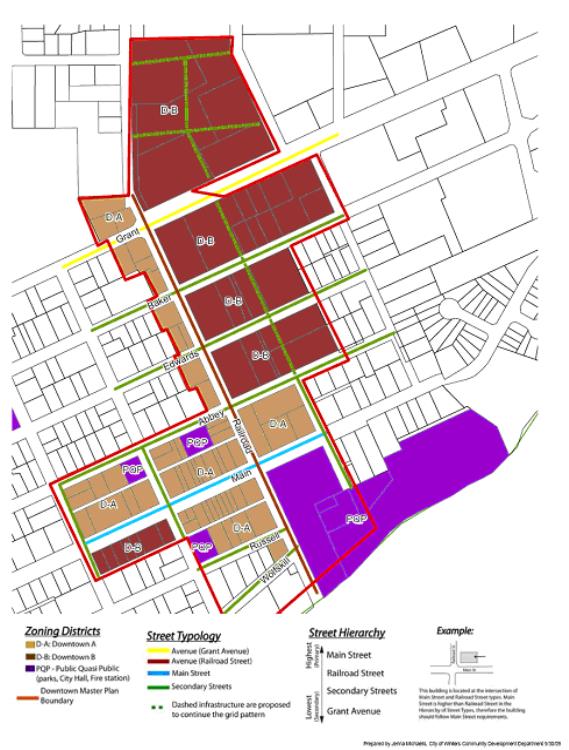
B. Street Typologies and Standards. The purpose of this section is to provide roadway standards that will facilitate the creation of streets that are inviting, multimodal public places for vehicular traffic, bicyclists, and pedestrians. These streetscape typologies and standards are unique to this chapter and are intended to implement the vision of the 2006 Winters downtown master plan.
1. Street Typologies. The streetscape typologies allowed in zones D-A and D-B are listed below:
a. Avenue (Grant Avenue and Railroad Avenue). Avenues connect districts or regions and are capable of carrying a high amount of vehicular traffic while still maintaining a higher quality pedestrian environment and retail-supporting urban edge. This street typology may be used in place of an arterial.
The landscaping strip along the sides of the roadway should be designed to facilitate the safe passage of pedestrians. It is suggested that the strip include a continuous landscaped area between the edge of the curb and the sidewalk. This area should include street trees and lighting designed at a pedestrian scale. Landscape strips should be a minimum of five feet wide, where feasible, in the area south of Grant Avenue. Additionally, Grant Avenue corridor pedestrian pathways are designated to be at least eight feet wide with landscape strips that are also eight feet wide. This width allows large tree canopy shade for pedestrians, and creates a buffer from high volume traffic.
Wherever an avenue intersects with another avenue, Main Street, or a neighborhood street, the intersection should be designed to enhance pedestrian safety and convenience. Features may include pedestrian bulbouts, differentiated accent paving within the intersection, in-street crossing lights (if there is no crosswalk signal), and pedestrian refuge areas within the medians of avenues.
b. Main Street. Street trees should frequently interrupt the parking lanes to soften visual impact of the parked vehicles and to help cool the air heated by the pavement.
Diagonal parking and wide sidewalks should create a safe, inviting environment for both pedestrians and motorists.
Wherever a main street intersects with an avenue or a neighborhood street, the intersection should be designed to provide pedestrians with safe passage. Features may include pedestrian bulbouts, differentiated accent paving within the intersection, and in-street crossing lights (if there is no crosswalk signal).
Turning movements typically occur from within the main travel lanes; however, short (one to two car-lengths) turn pockets may be provided at some intersections in lieu of parking on one side of the street.
c. Secondary Streets. Neighborhood streets are home to the majority of residential development in downtown Winters as well as a few small offices and neighborhood-serving retail stores. These streets have a more intimate nature than the other areas and due to this landscaping and larger street trees should frequently interrupt the parking lanes to soften visual impact of the parked vehicles and to help cool the air heated by the pavement.
d. Alley. Alleys are narrow public drives serving commercial and residential development. In commercial developments, alleys provide the primary service access and loading areas for businesses.
Customer entrances may also be located off of alleys. In addition, if it does not obstruct the flow of vehicular and pedestrian traffic, portions of the alley may be used for outdoor retail space, patios, art gardens, and related uses. In residential development, parking should be accessed via alleys.
Alley street lighting and landscaping should be designed at a pedestrian scale with an emphasis on creating an inviting, safe and secure environment. Additionally, landscaping shall not impede automobile or pedestrian visibility within or immediately adjacent to an alley.
e. Paseo. Paseos are local and private pathways serving pedestrians and bicyclists only, and may also provide limited service access during specified periods of the day. In addition, if it does not obstruct the flow of pedestrian traffic, portions of the paseo may also be used for outdoor dining, retail space, patios, art gardens, and related uses.
These types of “streets” are not shown on the regulating plan but are appropriate to include in the D-B district as part of a unified development plan to connect uses and activities in a pedestrian orientation without additional public rights-of-way. Paseos could also be used in the D-A district when connecting front (street) and rear (alley) activity areas of the commercial block.
Paseo street lighting and landscaping should be designed at a pedestrian scale. Larger canopy trees should be used where possible for shade.
2. Street Typology Standards. The following table displays associated standards for each street typology.
|
|
Grant Avenue |
Railroad Avenue |
Main Street |
Secondary Streets |
Alley |
Paseo |
|
Thoroughfare Type: |
Avenue |
Avenue |
Collector |
Local |
Alley |
Pathway |
|
Right-of-Way Width: |
60 – 126 feet |
60 – 80 feet |
60 feet |
44 – 60 feet |
15 – 25 feet |
20 – 100 feet |
|
Through Traffic Lanes: |
2 – 4 lanes |
2 lanes |
2 lanes |
2 lanes1 |
1 lane |
Emergency only |
|
Turning Lanes: |
N/A |
N/A |
Optional turn pockets |
N/A |
N/A |
N/A |
|
Parking Lanes: |
N/A |
9.5 feet wide minimum, diagonal, each side |
9 feet wide minimum, diagonal, each side |
9 feet wide, parallel, one or two sides |
N/A |
N/A |
|
Planter Strip Width: |
8 feet |
5 feet |
4 feet |
4 feet |
N/A |
N/A |
|
Curb Radius: |
25 feet2 |
25 feet |
25 feet |
25 feet |
25 feet |
25 feet |
|
Bicycle Facilities: |
On-street, stripped |
On-street, stripped |
On-street, not stripped |
On-street, not stripped |
N/A |
Designated bicycle lane(s) |
1 While Wolfskill Street is identified as a secondary street, due to its narrow width it is only improved to a narrow one-lane, one-way street.
2 Twenty-five (25) feet is ideal but actual curb radius shall be determined in consultation with CalTrans and the city engineer.
(Ord. 2009-10 § 1 Exh. 1 (part))
17.58.050 Allowed use regulations.
This section lists allowed uses by zoning district within the downtown form-based code area. The zoning districts are shown on the regulating plan (Figure 17.58-1). This list is not meant to be comprehensive and does not regulate building character or design, but instead delineates the types of uses allowed within a building. These allowed use regulations are unique to this chapter and are intended to implement the vision of the 2006 Winters downtown master plan.
A. Principally Permitted Uses. The following table identifies the permitted uses within the downtown. These allowed use regulations are listed by street type, then by zoning district (D-A or D-B), as applicable. The uses listed are defined in subsection B of this section (Definitions of Permitted Uses). The symbols in the table are defined as:
P—Permitted Use
C—Conditionally Permitted Use
N—Not Permitted
|
Uses |
Main Street |
Railroad Avenue |
Secondary Streets |
Grant Avenue |
||||
|
D-A |
D-B |
D-A |
D-B |
D-A |
D-B |
D-A |
D-B |
|
|
Attached Single-Family Residential |
N |
N |
N |
N |
N |
P |
N |
N |
|
Banks and Financial Institutions |
P |
P |
P |
P |
P |
C |
P |
P |
|
Bars, Pubs and Cocktail Lounges |
C |
C |
C |
C |
N |
N |
C |
C |
|
Bed and Breakfast Inns |
P1 |
P1 |
P1 |
P |
P |
P |
P1 |
P |
|
Businesses and Uses Prohibited by State or Federal Law |
N |
N |
N |
N |
N |
N |
N |
N |
|
Child Day Care |
N |
N |
N |
N |
C |
C |
N |
C |
|
Commercial Recreation and Entertainment |
C |
C |
C |
C |
N |
N |
C |
C |
|
Detached Single-Family Residential |
N |
C |
N |
N |
C |
P |
N |
N |
|
Farmworker Housing Unit |
C1,3 |
C1,3 |
C1,3 |
C1,3 |
C1,3 |
P |
C1,3 |
C1,3 |
|
Farmworker Housing Complex |
|
|
|
|
|
P3 |
|
|
|
Government/Institutional |
P |
P |
P |
P |
P |
C |
P |
P |
|
Hotels or Motels |
P1 |
P1 |
P1 |
P1 |
P |
P |
P1 |
P |
|
Live/Work Units |
C |
P |
P |
P |
P |
C |
N |
C |
|
Mixed-Uses |
P |
P |
P |
P |
P |
C |
C |
P |
|
Multifamily Residential |
C1 |
P1 |
P1 |
P1 |
P1 |
P |
N |
P1 |
|
Neighborhood Commercial |
P |
P |
P |
P |
P |
C |
C |
N |
|
Offices |
P |
P |
P |
P |
P |
C |
P |
P |
|
Personal Services |
P |
P |
P |
P |
P |
C |
C |
P |
|
Religious Institutions |
C |
C |
C |
C |
N |
N |
C |
C |
|
Retail Commercial |
P |
P |
P |
P |
P |
N |
P |
P |
|
Service Stations |
N |
C |
C |
C |
N |
N |
C |
C |
|
Single Room Occupancy |
C1 |
C1 |
C1 |
C1 |
C1 |
C1 |
C1 |
C1 |
|
Sit-Down Restaurants2 |
P |
P |
P |
P |
C |
C |
P |
P |
|
Specialized Agriculture and Processing |
C |
C |
C |
C |
C |
C |
C |
C |
|
Stationary Food Vendor |
C |
C |
C |
C |
C |
C |
C |
C |
Notes:
1 Only on the second floor or above.
2 Drive-thrus are not allowed within the downtown form-based code area (see Section 17.58.070(A)(2)(d)).
3 For single farmworkers, single room occupancy housing is permitted.
B. Definitions of Permitted Uses.
1. “Attached single-family residential” means a building designed exclusively for occupancy by one family on a single lot that has zero-foot side yard setbacks, and shares a party wall with the adjacent building(s) (e.g., townhouse).
2. “Banks” and “financial institutions” mean financial institutions such as banks and trust companies, credit agencies, holding companies, lending and thrift institutions, and investment companies. Also includes automated teller machines (ATMs).
3. “Bars,” “pubs” and “cocktail lounges” means establishments, including brew pubs, which are primarily designed, maintained, operated, used or intended to be used for the selling and on-site consumption of beer, wine and/or distilled spirits. Food sales may be incidental to the bar use. Live entertainment may also be offered as an incidental use if conducted within a building. The storage and sale of alcoholic beverages, including a liquor store, is included in this classification.
4. “Bed and breakfast inns” means residential structures with up to four bedrooms rented for overnight lodging, where meals may be provided subject to applicable Health Department regulations. A bed and breakfast inn with more than four guest rooms is considered a hotel or motel.
5. “Child day care” means a state-licensed facility which provides nonmedical care, protection and supervision to children under eighteen (18) years of age, on a less than twenty-four (24) hour basis. Commercial or nonprofit child day care facilities include infant centers, preschools, sick-child centers, and school-age day care facilities. These may be operated in conjunction with a school or church facility, or as an independent land use.
6. “Commercial recreation and entertainment” means establishments providing indoor or outdoor recreation and entertainment services including: bars, movie theaters, dance halls, electronic game arcades, bowling alleys, billiard parlors, ice/roller skating rinks, health clubs, skateboard parks.
7. “Detached single-family residential” means a building designed exclusively for occupancy by one family on a single lot. This classification includes manufactured homes (defined in California Health and Safety Code Section 18007).
8. Government/Institutional. This use includes government agency and service facilities (e.g., post office, civic center, police department, fire department), as well as public educational facilities, and publicly owned parkland.
9. “Hotel” or “motel” means a facility with guest rooms or suites, with or without kitchen facilities, rented to the general public for transient lodging. Hotels typically include a variety of services in addition to lodging; for example, restaurants, meeting facilities, personal services, etc. Also includes accessory guest facilities such as swimming pools, tennis courts, indoor athletic facilities, accessory retail uses, etc.
10. “Live/work unit” means an integrated housing unit and working space, occupied and utilized by a single household in a structure, either single-family or multifamily, that has been designed or structurally modified to accommodate joint residential occupancy and work activity, and which includes:
a. Complete kitchen space and sanitary facilities in compliance with the city building code; and
b. Working space reserved for and regularly used by one or more occupants of the unit.
11. “Mixed-use” facilities are characterized by commercial retail use on the ground floor, and office, hotel, or residential uses on the upper floors.
12. “Multifamily residential” means a building designed and intended for occupancy by two or more families living independent of each other, each in a separate dwelling unit, which may be owned individually or by a single landlord (e.g., duplex, triplex, quadplex, apartment, apartment house, condominium). Also includes senior housing.
13. “Neighborhood commercial” means a pedestrian-oriented market store oriented to the daily shopping needs of the surrounding residential areas. Neighborhood markets are less than eight thousand (8,000) square feet in size and operate no more than eighteen (18) hours a day. Neighborhood markets may include deli or beverage tasting facilities that are ancillary to the market/grocery portion of the use. Alcohol sales are allowed for off-site consumption, or on-site consumption as part of the beverage tasting facility only.
14. Offices. This use includes businesses providing direct services to consumers (e.g., insurance companies, utility companies), professional offices (e.g., accounting, attorneys, doctors, dentists, employment, public relations, real estate), and offices engaged in the production of intellectual property (e.g., advertising, architectural, computer programming, photography studios).
15. “Personal services” means establishments providing nonmedical services as a primary use, including, but not limited to, barber and beauty shops, clothing rental, dry cleaning pick-up stores with limited equipment, day spas, laundromats (self-service laundries), printing and reproduction, business support services, shoe repair shops, and tailors. These uses may also include accessory retail sales of products related to the services provided.
16. “Religious institutions” means facilities operated by religious organizations for worship, or the promotion of religious activities (e.g., churches, mosques, synagogues, temples) and accessory uses on the same site (e.g., living quarters for ministers and staff, child day care facilities) which were authorized in conjunction with the primary use. Other establishments maintained by religious organizations, such as full-time educational institutions, hospitals and other potentially related operations (e.g., recreational camp) are classified according to their respective activities.
17. “Retail commercial” means stores and shops selling multiple lines of merchandise. These stores and lines of merchandise include but are not limited to art galleries, bakeries (all production in support of on-site sales), clothing and accessories, collectibles, department stores, drug stores, dry goods, fabrics and sewing supplies, florists and houseplant stores, furniture, home furnishings and equipment, general stores, gift shops, hardware, hobby materials, musical instruments, parts and accessories, newsstands, pet supplies, specialty shops, sporting goods and equipment, and stationery stores.
18. “Service station” means a retail business selling motor vehicle fuels, related products and providing vehicle services. Body work is not permitted. Boundary landscaping is required along all property lines abutting streets, except for driveways. Landscaped areas shall have a minimum width of five feet, and shall be separated from abutting vehicular areas by a wall or curbing at least six inches higher than the abutting pavement. Planters at the pump islands are encouraged.
19. “Single room occupancy” means a facility providing dwelling units where each unit has a minimum floor area of one hundred fifty (150) feet and a maximum floor area of four hundred (400) square feet. These dwelling units may have kitchen or bathroom facilities and shall be offered on a monthly basis or longer.
20. “Sit-down restaurant” means a retail business selling food and beverages prepared and/or served on the site for on-premises consumption where most customers are served food at tables, but may include providing food for take-out. Also includes coffee houses, and accessory cafeterias as part of office and industrial uses. Alcohol sales are allowed for on-site consumption only.
21. “Specialized agriculture and processing” means establishments that provide locally produced foods and spirits including but not limited to produce, cheese, beer, and wine for retail, on-site sale. This use includes on-site agricultural processing in support of the on-site retail activities. (Ord. 2018-06 § 3(c); Ord. 2012-08 § 5; Ord. 2011-07 §§ 5, 6; Ord. 2011-05 § 6 (Att. 2); Ord. 2009-10 § 1 Exh. 1 (part))
17.58.060 Development standards.
Development standards are intended to encourage, protect, and preserve the historic urban image of downtown Winters. They are also intended to improve overall aesthetic appearance and to serve as an incentive for private investment in the downtown area.
An important initiative of the Winters form-based code for downtown is to clearly spell out development standards that shape the desired urban form. Building intensities are regulated through conformance to the prescribed development standards and design guidelines (e.g., height, setbacks, parking, form, massing). These standards are designed to simplify, streamline, and customize the standards and requirements described in this title and to encourage preservation, investment, and revitalization of property in the downtown area.
A. General Development Standards.
1. Mandatory Conformance. Standards listed in this section, as well as architectural and design standards listed in Section 17.58.070, are mandatory requirements that must be satisfied for all new projects and modifications to existing development. Projects shall be reviewed for conformance with these provisions as part of design review. For “qualifying modifications” to existing development that only require issuance of a building permit, conformance with these standards shall be reviewed as part of plan check during building permit review. “Qualifying modifications” are all modifications to a structure except repair, restoration, or reconstruction of a structure where such work, as determined by the community development director, maintains the outer dimensions and surface relationships of the existing structure (e.g., repainting, replacement of windows or doors with matching size and style, repair of exterior materials such as stucco, brick, and wood).
2. Area-Wide Maximum Allowable Residential Development. The maximum allowable residential development in downtown Winters is twenty (20) dwelling units per acre.
B. Height Requirements. The maximum height of forty-five (45) feet in downtown Winters is intended to preserve the compact, walkable, historic downtown core while simultaneously stimulating economic development in the commercial heart of the city.
Table 17.58-3 displays height requirements for each downtown Winters district.
|
Maximum |
Main Street |
Railroad Avenue |
Secondary Streets |
Grant Avenue |
||||
|
D-A |
D-B |
D-A |
D-B |
D-A |
D-B |
D-A |
D-B |
|
|
|
45 feet |
45 feet |
45 feet |
45 feet |
35 feet |
35 feet |
45 feet |
45 feet |
The zoning administrator or planning commission may approve architectural features such as tower elements, elevator service shafts, and roof access stairwells that extend above the height limit. Telecommunications antennas and service structures located on rooftops may also exceed the maximum building height but shall be hidden to the maximum extent possible using appropriate screening and “stealth” technologies.
As part of the design review, and on the recommendation of the planning commission, the city council may approve buildings that exceed the maximum height adopted in the D-A or D-B zones.
C. Frontage Types. Frontage type refers to the architectural composition of the front facade of a building, particularly concerning how it relates and ties into the surrounding public realm. The downtown Winters frontage types are intended to enhance social interactions in the historic downtown retail core while simultaneously providing appropriate levels of privacy in residential areas. Allowed frontage types in the different districts and along the four street types are listed in Table 17.58-4 and defined below. An “X” means that the frontage type is allowed; a blank cell means that the frontage type is not allowed.
|
Allowed Frontage Types |
Main Street |
Railroad Avenue |
Secondary Streets |
Grant Avenue |
||||
|
D-A |
D-B |
D-A |
D-B |
D-A |
D-B |
D-A |
D-B |
|
|
Arcade |
X |
X |
X |
X |
X |
X |
|
|
|
Gallery |
X |
X |
X |
X |
X |
X |
|
|
|
Storefront |
X |
X |
X |
X |
X |
X |
X |
X |
|
Stoop |
|
X |
|
|
X |
X |
|
|
|
Door Yard/Terrace |
|
X |
|
X |
X |
X |
|
|
|
Porch |
|
X |
|
|
X |
X |
|
|
|
Neighborhood Yard |
|
X |
|
|
X |
X |
|
|
|
Alley/Paseo |
X |
X |
X |
X |
X |
X |
|
X |
Arcade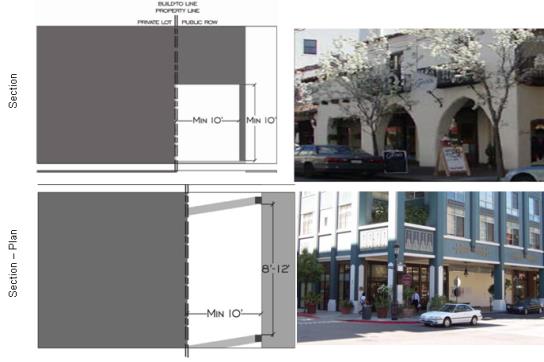
• Depth = Ten (10) feet minimum from the build-to line to the inside column face.
• Height = Ten (10) feet minimum clear.
• Seventy-five (75) percent to one hundred (100) percent of the building front.
An arcade frontage is nearly identical in character to the gallery frontage except that the upper stories of the building may project over the public sidewalk and encroach into the public right-of-way.
The sidewalk must be fully absorbed within the colonnade so that a pedestrian may not bypass it.
This frontage is typically for retail use.
An encroachment permit is needed to construct this frontage type.
|
Building Placement |
Main Street |
Railroad Avenue |
Secondary Streets |
Grant Avenue |
||||
|
D-A |
D-B |
D-A |
D-B |
D-A |
D-B |
D-A |
D-B |
|
|
Build-To Front Line1 |
0 feet |
0 feet |
0 feet |
0 feet |
0 feet |
0 feet |
|
|
|
Minimum Side Yard |
0 feet |
0 feet |
0 feet |
0 feet |
0 feet |
0 feet |
|
|
|
Minimum Rear Yard2 |
0 feet |
10 feet |
10 feet |
20 feet |
10 feet |
20 feet |
|
|
1 Build-to lines are defined as the edge where the public right-of-way ends and the private property boundary begins. It is the maximum distance from the property line a front or street side building facade can be placed. Typically, build-to lines range from zero feet to ten (10) feet.
2 Alley-loaded garages may be located with a zero-foot rear yard setback.
Building Placement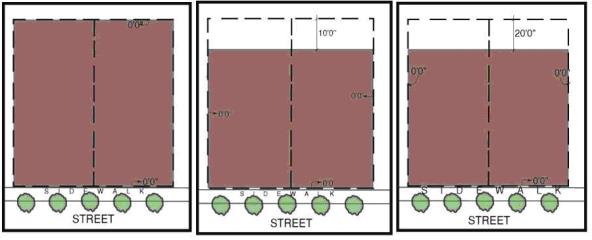
|
|
Main Street D-A |
Railroad Avenue D-A |
Railroad Avenue D-B |
|
|
|
Secondary Street D-A |
Secondary Street D-B |
|
|
|
Main Street D-B |
|
Gallery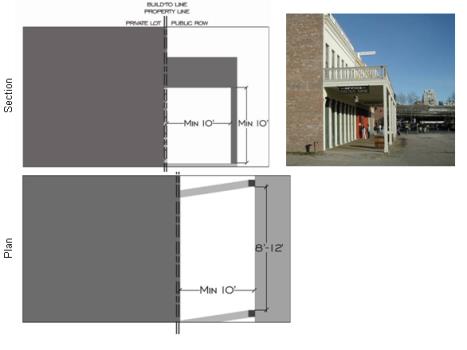
• Depth = Ten (10) feet minimum from the build-to line to the inside column face.
• Height = Ten (10) feet minimum clear.
• Seventy-five (75) percent to one hundred (100) percent of the building front.
A gallery frontage is characterized by a facade which is aligned close to or directly on the right-of-way line with the building entrance at sidewalk grade, and with an attached colonnade that projects over the public sidewalk and encroaches into the public right-of-way.
The sidewalk must be fully absorbed within the colonnade so that a pedestrian may not bypass it.
This frontage is typically for retail use.
An encroachment permit is needed to construct this frontage type.
|
Building Placement |
Main Street |
Railroad Avenue |
Secondary Streets |
Grant Avenue |
||||
|
D-A |
D-B |
D-A |
D-B |
D-A |
D-B |
D-A |
D-B |
|
|
Build-To Front Line1 |
0 feet |
0 feet |
0 feet |
0 feet |
0 feet |
0 feet |
|
|
|
Minimum Side Yard |
0 feet |
0 feet |
0 feet |
0 feet |
0 feet |
0 feet |
|
|
|
Minimum Rear Yard2 |
0 feet |
10 feet |
10 feet |
20 feet |
10 feet |
20 feet |
|
|
1 Build-to lines are defined as the edge where the public right-of-way ends and the private property boundary begins. It is the maximum distance from the property line a front or street side building facade can be placed. Typically, build-to lines range from zero feet to ten (10) feet.
2 Alley-loaded garages may be located with a zero-foot rear yard setback.
Note: A blank cell indicates that frontage type is not allowed in that zone.
Building Placement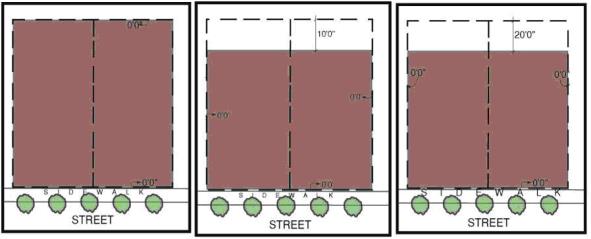
|
|
Main Street D-A |
Railroad Avenue D-A |
Railroad Avenue D-B |
|
|
|
Secondary Street D-A |
Secondary Street D-B |
|
|
|
Main Street D-B |
|
Storefront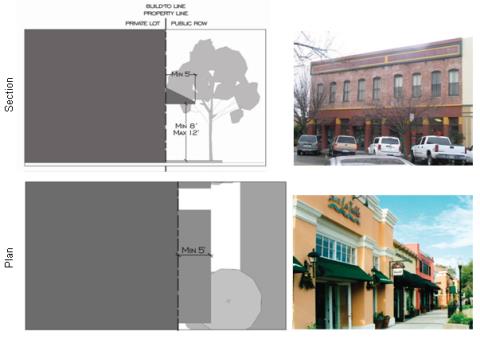
• Depth = Five feet minimum over the sidewalk.
• Height = Eight feet minimum clear, twelve (12) feet maximum.
• Minimum of fifty (50) percent of the overall building frontage.
A storefront frontage is characterized by a facade which is aligned close to or directly on the right-of-way line with the building entrance at sidewalk grade.
Storefront frontage has substantial glazing on the ground floor.
Storefront frontages provide awnings or canopies cantilevered over the sidewalk.
Building entrances may either provide a canopy or awning or, alternatively, may be recessed behind the front building facade.
|
Building Placement |
Main Street |
Railroad Avenue |
Secondary Streets |
Grant Avenue |
||||
|
D-A |
D-B |
D-A |
D-B |
D-A |
D-B |
D-A |
D-B |
|
|
Build-To Front Line1 |
0 feet |
0 feet |
0 feet |
0 feet |
0 feet |
0 feet |
10 feet |
10 feet |
|
Minimum Side Yard |
0 feet |
0 feet |
0 feet |
0 feet |
0 feet |
0 feet |
15 feet |
15 feet |
|
Minimum Rear Yard2 |
0 feet |
10 feet |
10 feet |
20 feet |
10 feet |
20 feet |
20 feet |
20 feet |
1 Build-to lines are defined as the edge where the public right-of-way ends and the private property boundary begins. It is the maximum distance from the property line a front or street side building facade can be placed. Typically, build-to lines range from zero feet to ten (10) feet.
2 Alley-loaded garages may be located with a zero-foot rear yard setback.
Building Placement
|
Main Street D-A |
Railroad Avenue D-A |
Railroad Avenue D-B |
Grant Avenue |
|
|
Secondary Street D-A |
Secondary Street D-B |
|
|
|
Main Street D-B |
|
|
Stoop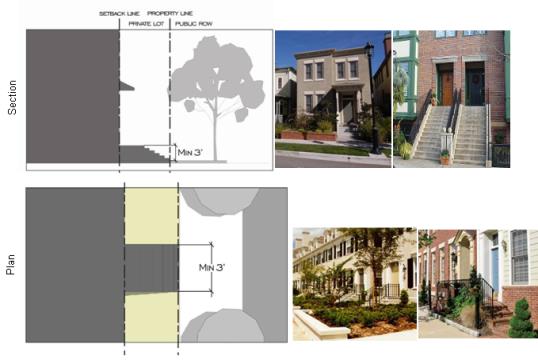
• Stoops must rise to a minimum of three feet above grade.
• Stoop is a minimum of three feet wide.
A stoop frontage is characterized by a facade which is aligned close to the frontage line with the ground story elevated from the sidewalk to provide privacy for the ground floor uses.
The entrance is usually an exterior stair or landing which may be combined with a small porch or roof.
The stoop frontage type is suitable for ground floor residential uses with short setbacks.
|
Building Placement |
Main Street |
Railroad Avenue |
Secondary Streets |
Grant Avenue |
||||
|
D-A |
D-B |
D-A |
D-B |
D-A |
D-B |
D-A |
D-B |
|
|
Front Setback Line |
|
3—10 feet |
|
|
3—10 feet |
3—10 feet |
|
|
|
Minimum Side Yard |
|
0—3 feet |
|
|
0—3 feet |
0—3 feet |
|
|
|
Minimum Rear Yard1 |
|
10 feet |
|
|
10 feet |
20 feet |
|
|
1 Alley-loaded garages may be located with a zero-foot rear yard setback.
Note: A blank cell indicates that frontage type is not allowed in that zone.
Building Placement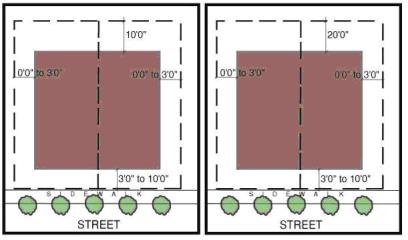
|
Secondary Street D-A |
Secondary Street D-B |
|
Main Street D-B |
Door Yard/Terrace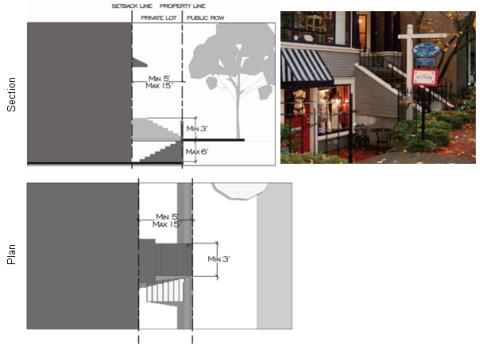
• Minimum of three feet above grade.
• Minimum of three feet wide.
A door yard/terrace frontage is characterized by a facade that is set back from the street property line and multiple levels of the building directly accessible from the street.
Door yard/terrace is a variation on the stoop frontage, but it provides opportunities for multiple levels of commercial/retail easily accessible from the street.
Could also be used for a lower-level commercial use with office or residential on the second level.
|
Building Placement |
Main Street |
Railroad Avenue |
Secondary Streets |
Grant Avenue |
||||
|
D-A |
D-B |
D-A |
D-B |
D-A |
D-B |
D-A |
D-B |
|
|
Front Setback Line |
|
5—15 feet |
|
5—10 feet |
5—15 feet |
5—15 feet |
|
|
|
Minimum Side Yard |
|
0—3 feet |
|
0 feet |
0—3 feet |
0—3 feet |
|
|
|
Minimum Rear Yard1 |
|
10 feet |
|
20 feet |
10 feet |
20 feet |
|
|
1 Alley-loaded garages may be located with a zero-foot rear yard setback.
Note: A blank cell indicates that frontage type is not allowed in that zone.
Building Placement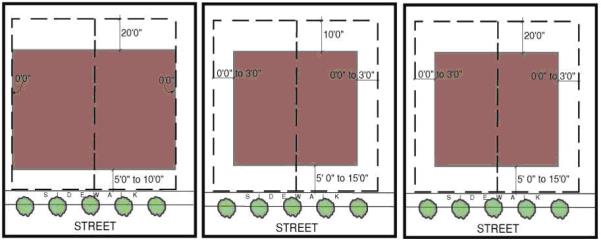
|
Railroad Avenue D-B |
Secondary Streets D-A |
Secondary Streets D-B |
|
|
Main Street D-B |
|
Porch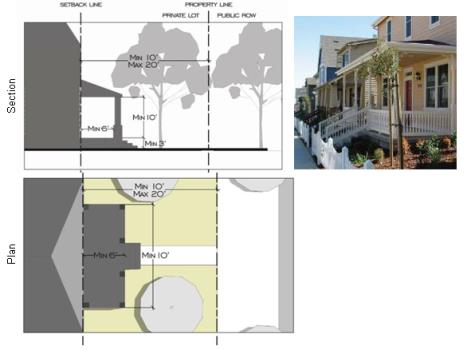
• Minimum of ten (10) feet tall (clear).
• Minimum of six feet deep (clear).
• Porch height must be a minimum of three feet above grade.
• Minimum of ten (10) feet wide.
This frontage type is characterized by a facade which is set back from the property line with a front yard, and by a porch which is appended to the front facade.
The porch may encroach into the front setback.
|
Building Placement |
Main Street |
Railroad Avenue |
Secondary Streets |
Grant Avenue |
||||
|
D-A |
D-B |
D-A |
D-B |
D-A |
D-B |
D-A |
D-B |
|
|
Front Setback Line |
|
10—20 feet |
|
|
10—20 feet |
10—20 feet |
|
|
|
Minimum Side Yard |
|
3—5 feet |
|
|
3—5 feet |
3—5 feet |
|
|
|
Minimum Rear Yard1 |
|
10 feet |
|
|
10 feet |
20 feet |
|
|
1 Alley-loaded garages may be located with a zero-foot rear yard setback.
Note: A blank cell indicates that frontage type is not allowed in that zone.
Building Placement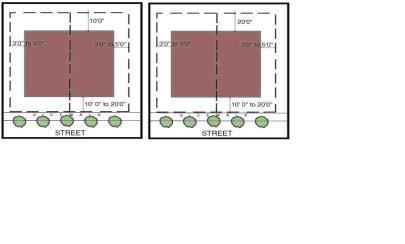
|
Secondary Streets D-A |
Secondary Streets D-B |
|
Main Street D-B |
Neighborhood Yard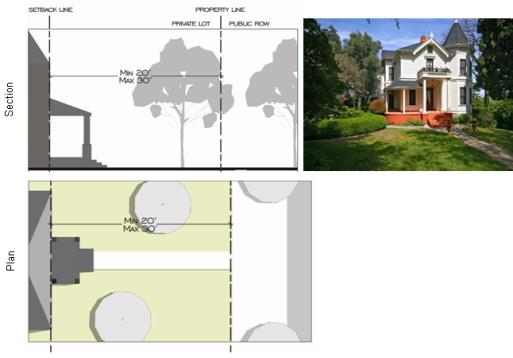
• Minimum twenty (20) foot setback.
• Maximum thirty (30) foot setback.
A neighborhood yard frontage is characterized by deep front yard setbacks. The building facade is set back substantially from the front property line. The resulting front yard is unfenced and is visually continuous with adjacent yards, supporting a common landscape. Porches and/or stoops are not required, though they are recommended.
|
Building Placement |
Main Street |
Railroad Avenue |
Secondary Streets |
Grant Avenue |
||||
|
D-A |
D-B |
D-A |
D-B |
D-A |
D-B |
D-A |
D-B |
|
|
Front Setback Line |
|
20—30 feet |
|
|
20—30 feet |
20—30 feet |
|
|
|
Minimum Side Yard |
|
5 feet |
|
|
5 feet |
5 feet |
|
|
|
Minimum Rear Yard1 |
|
10 feet |
|
|
10 feet |
20 feet |
|
|
1 Alley-loaded garages may be located with a zero-foot rear yard setback.
Note: A blank cell indicates that frontage type is not allowed in that zone.
Building Placement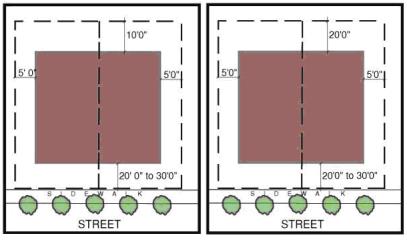
|
Secondary Streets D-A |
Secondary Streets D-B |
|
Main Street D-B |
|
Alley/Paseo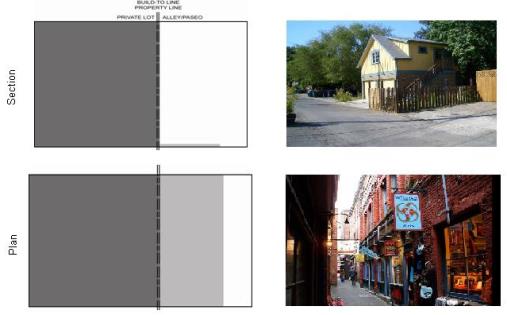
An alley is a narrow public drive serving commercial and residential development. In commercial developments, alleys provide the primary service access and loading areas for businesses.
Paseos are local and private pathways serving pedestrians and bicyclists only, and may also provide limited service access during specified periods of the day. In addition, if it does not obstruct the flow of pedestrian traffic, portions of the paseo may also be used for outdoor dining, retail space, patios, art gardens, and related uses.
In commercial areas this type of frontage allows for buildings along the property line as well as the integration of courtyards into the property. When a ground-level courtyard is developed for a commercial or mixed-use building, the courtyard may encompass any portion of the facade (e.g., zero percent to one hundred (100) percent). The maximum depth of the courtyard, as measured from the alley or paseo, is thirty-five (35) percent of the lot depth.
|
Building Placement |
Main Street |
Railroad Avenue |
Secondary Streets |
Grant Avenue |
||||
|
D-A |
D-B |
D-A |
D-B |
D-A |
D-B |
D-A |
D-B |
|
|
Build-To Front Line1 |
0 feet |
0 feet |
0 feet |
0 feet |
0 feet |
0 feet |
|
|
|
Minimum Side Yard |
0 feet |
0 feet |
0 feet |
0 feet |
0 feet |
0 feet |
|
|
|
Minimum Rear Yard |
0 feet |
0 feet |
0 feet |
0 feet |
0 feet |
0 feet |
|
|
1 Build-to lines are defined as the edge where the public right-of-way ends and the private property boundary begins. It is the maximum distance from the property line a front or street side building facade can be placed.
Building Placement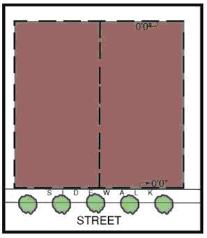
|
All Streets and Avenues |
D. Building Types. The following building types are intended to provide a variety of flexible building styles appropriate for the small-town character of Winters that can be used to guide future development. Allowed building types in the different districts and along the four street types are listed in Table 17.58-13 and defined below. An “X” means that the building type is allowed; a blank cell means that the building type is not allowed.
|
Allowed Building Types |
Main Street |
Railroad Avenue |
Secondary Streets |
Grant Avenue |
||||
|
D-A |
D-B |
D-A |
D-B |
D-A |
D-B |
D-A |
D-B |
|
|
Half Block Liner |
X |
X |
X |
X |
X |
X |
|
|
|
Infill |
X |
X |
X |
X |
X |
X |
|
|
|
Terraced |
|
X |
X |
X |
X |
X |
X |
X |
|
Front Yard Housing |
|
X |
|
|
X |
X |
|
|
|
Rowhouse |
|
|
|
X |
|
X |
|
|
|
Courtyard Housing |
|
|
|
X |
|
X |
|
|
1. “Half block liner” means an attached building with a frontage of approximately one-third to one-half the length of a downtown block, and zero side yard setbacks. It is used for mixed-use, residential, and commercial development.
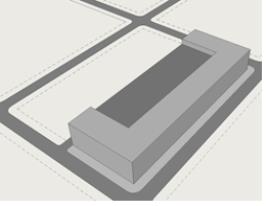
Half-Block Liner
2. “Infill” means an attached building with a frontage that is less than one-third the length of a downtown block, and zero side yard setbacks. It is used for mixed-use, residential, and commercial development.
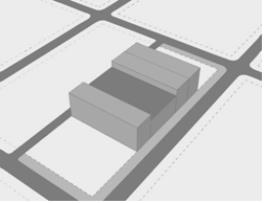
Infill Lot
3. “Terraced” means a mixed-use, residential, or commercial building characterized by individual units that are accessed via multi-leveled outdoor terraces. The terraces are intended to be semi-public spaces that are extensions of the public realm.
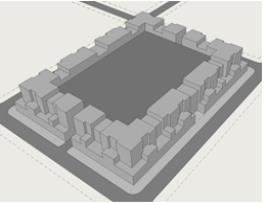
Terraced Lot
4. “Front yard housing” means a detached building designed as a single-family residence, duplex, triplex, or quadplex. Front yard housing is accessed from the sidewalk adjacent to the street build-to line.
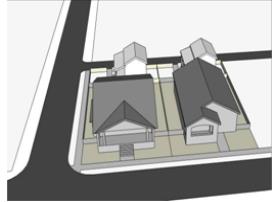
Front Yard Housing
5. “Rowhouse” means two or more detached two- or three-story dwellings with zero side yard setbacks. A rowhouse may be used for nonresidential purposes.
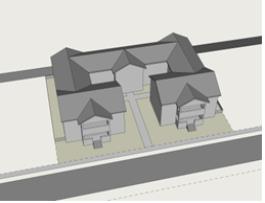
Courtyard Housing
6. “Courtyard housing” means a group of dwelling units arranged to share one or more common courtyards upon a qualifying lot in any zone. Dwellings take access from the street or the courtyard(s). Dwelling configuration occurs as townhouses, apartments, or apartments located over or under townhouses. The courtyard is intended to be a semi-public space that is an extension of the public realm.
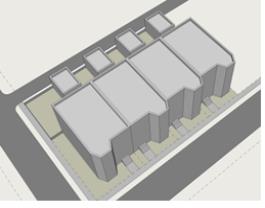
Rowhouse
E. Storefront Regulations. The following storefront standards are intended to provide continuity of building form at street level in downtown Winters. Additionally, standards are meant to enhance the relationship between buildings and the sidewalk, subsequently encouraging more pedestrian activity.
Table 17.58-14 lists the storefront design standards. “Tags” refer to those elements labeled in Figure 17.58-2 and described in subsection (F)(1) of this section (Storefront Design Standard Definitions). These standards shall also apply to alley and paseo development.
|
Storefront Standards |
Main Street |
Railroad Avenue |
Secondary Streets |
Grant Avenue |
||||
|
D-A |
D-B |
D-A |
D-B |
D-A |
D-B |
D-A |
D-B |
|
|
Storefront Width |
10—40 feet |
15—35 feet |
20—50 feet |
20—50 feet |
15—35 feet |
15—35 feet |
20—50 feet |
20—60 feet |
|
Tag “A” |
||||||||
|
Ground Floor Height |
12—18 feet |
10—15 feet |
12—18 feet |
12—18 feet |
10—15 feet |
10—15 feet |
12—20 feet |
12—20 feet |
|
Tag “B” |
||||||||
|
Bulkhead Height |
1.5—3 feet |
1.5—3 feet |
1.5—3 feet |
1.5—3 feet |
1.5—3 feet |
1.5—3 feet |
0—4 feet |
0—4 feet |
|
Tag “C” |
||||||||
|
Inset of Front Door from Build-To Line |
3—7 feet |
2—6 feet |
3—7 feet |
2—7 feet |
2—6 feet |
2—6 feet |
2—5 feet |
2—5 feet |
|
Tag “D” |
||||||||
|
Maximum Awning Extension from Building |
6 feet |
5 feet |
6 feet |
6 feet |
5 feet |
5 feet |
6 feet |
6 feet |
|
Tag “E” |
||||||||
1. Storefront Design Standard Definitions.
a. “Storefront width” refers to the front facade width as measured from one corner of the front facade to the other.
b. “Ground floor height” refers to the height of the front facade’s first story as measured from the sidewalk level to the top of the expression line. An “expression line” is an architectural embellishment that delineates the end of the ground floor and the start of the second floor of a building.
c. “Bulkhead height” refers to the height of the bulkhead, which is the portion of a commercial facade located between the ground and the bottom of the street level display windows. It is typically constructed of stone, brick, or concrete.
d. “Inset of front door from build-to line” refers to the distance from the front door of the building to the build-to line. A “build-to line” is an urban setback dimension that delineates the maximum distance from the property line a front building facade can be placed. Typically, build-to lines range from zero feet to ten (10) feet. See Table 17.58-7 for build-to line regulations in downtown Winters.
e. “Maximum awning extension from building” refers to the maximum distance allowed between the building and the end of a fully extended awning. An awning is a temporary shelter that is supported from the exterior wall of a building. It is typically constructed of canvas or a similar fabric that is sturdy and flexible.
Figure 17.58-2: Storefront Design Standards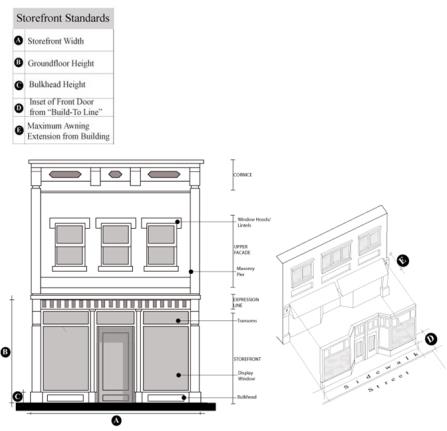
F. Parking. Parking requirements are intended to encourage pedestrian activity and economic growth in downtown Winters. Parking facilities should be located in the back or sides of buildings in order to maintain a continuous retail facade for pedestrians along downtown streets.
1. Allowable Parking Types. Allowable parking types are listed in Table 17.58-15 and depicted in Figure 17.58-3. An “A” means that the parking type is allowed; a “P” means that the parking type is preferred and highly encouraged. A blank cell means that the parking type is not allowed.
|
|
Main Street |
Railroad Avenue |
Secondary Streets |
Grant Avenue |
||||
|
D-A |
D-B |
D-A |
D-B |
D-A |
D-B |
D-A |
D-B |
|
|
Allowed Parking Types |
||||||||
|
Surface Parking—Behind Building |
P |
A |
P |
P |
A |
A |
P |
P |
|
Surface Parking— |
|
A |
A |
A |
A |
|
A |
A |
|
Alley Access |
A |
P |
A |
P |
P |
P |
A |
A |
|
Parking Structure |
|
|
A |
A |
|
|
|
A |
|
Tucked Under Building |
|
|
A |
A |
|
A |
A |
A |
|
Allowed Parking Ratios |
||||||||
|
Commercial |
1 space/400 sf |
1 space/400 sf |
1 space/400 sf |
1 space/400 sf |
1 space/400 sf |
|||
|
Office |
1 space/500 sf |
1 space/500 sf |
1 space/500 sf |
1 space/500 sf |
1 space/500 sf |
|||
|
Residential |
N/A |
1.5 spaces/unit |
1.5 spaces/unit |
1.75 spaces/unit |
N/A |
|||
|
Allowed Bicycle Parking Ratios |
||||||||
|
Commercial/Office |
0.3 space/ 1,000 sf |
0.3 space/ 1,000 sf |
0.3 space/1,000 sf |
0.3 space/1,000 sf |
0.3 space/1,000 sf |
|||
|
Residential |
N/A |
1 space/unit |
1 space/unit |
1 space/unit |
N/A |
|||
Figure 17.58-3: Parking Types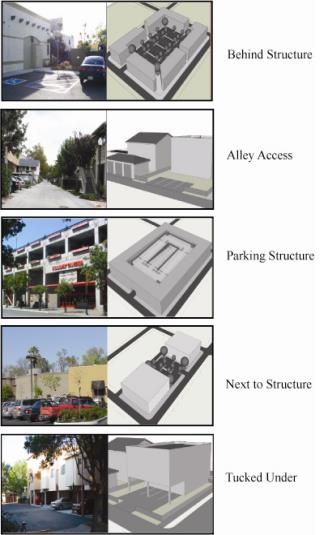
2. Parking Standards. Downtown Winters should encourage “one-stop” parking where shoppers park once and visit multiple stores on foot. In addition, reduced parking requirements and shared parking lots will help create a pedestrian-oriented downtown environment.
a. Locating parking lots between the front property line and the building storefront is prohibited. Instead, parking should be located to the rear of buildings.
b. When off-street parking in the rear is not possible, the visual impact of headlight bleed and the asphalt parking surface shall be minimized by landscaped berms and/or walls with a maximum height of three feet.
c. Rear parking lots should be designed and located contiguously, or adjacent to alleys, so that vehicles can travel from one private parking lot to the other either directly or via an alley without having to enter a street. This may be achieved with reciprocal shared access agreements.
d. In order to minimize conflicting vehicle turning movement along major roadways, the city encourages shared access drives within and between integrated nonresidential developments. This reduces the number of driveway curb cuts. The city also encourages reciprocal access between nonresidential developments to provide for convenience, safety, and efficient circulation. If incorporated, a reciprocal access agreement shall be recorded with the land by the owners of abutting properties to ensure that there will be continued availability of the shared access.
e. Parking areas that accommodate a significant number of vehicles should be divided into a series of connected smaller lots. Landscaping and offsetting portions of the lot are effective in reducing the visual impact of larger parking areas.
f. Demarcation of parking spaces should be legible, and the spaces should be adequate but not overly generous.
g. Locate rear parking lots or structure entries on side streets or alleys in order to minimize pedestrian/vehicular conflicts.
h. Create wide, well-lit, landscaped pedestrian walkways connecting on-site pedestrian circulation systems in parking lots to off-site public sidewalks and building entries.
i. The layout of parking areas should be designed so that pedestrians walk parallel to moving cars.
j. Parking structures (privately owned and operated) are encouraged to incorporate retail and/or office space on the street level of the structure. This prevents the structure from becoming a pedestrian “dead zone” in downtown Winters.
G. Landscaping. Landscaping in downtown Winters should be pedestrian-oriented and reflect and enhance the area’s small-town charm. These provisions emphasize the use of potted plants, trees, landscaping along urban streetscapes, and within urban parking lots. Landscaping shall be provided on-site consistent with the standards set forth below:
1. Landscaping Standards.
a. Street Trees. Street trees shall be provided every thirty (30) feet on center within the required landscape area. Tree selection shall be from the city’s adopted street tree list and as approved to the satisfaction of the community development director.
b. Standard Design Concepts.
i. Use landscaping to complement the architecture, provide visual interest, to minimize the impact of incompatible land uses, and to establish a transition between adjacent developments. Plant materials can absorb sound, filter air, curtail erosion, provide shade, and maintain privacy.
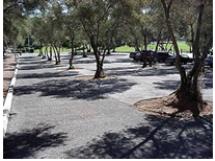
Tree canopies in parking lots provide shade.
ii. Provide landscaping to break up blank walls, shade pedestrians, accent entries, and soften the connection of paving for vehicles to buildings.
iii. Landscaping strips on public streets should be wide enough for canopy shade that is consistent with the street width. See standards for landscape area width in Section 17.58.040.
iv. The use of alternative types of landscaping strip ground cover is strongly encouraged. Standard grass strip is discouraged.
v. Parking facilities shall attain and maintain a minimum of fifty (50) percent tree canopy coverage within ten (10) years of completion of construction to provide shade and minimize visual and environmental impacts.
vi. In surface parking lots, trees should be installed at a ratio of one tree per three parking stalls for the perimeter of the parking lot, and one tree per six spaces for the interior of the parking lot.
vii. Placement of trees and shrubs should not conflict with vehicular overhangs, traffic and visibility patterns, and on-site structures.
viii. Owners of vacant lots without any structures shall seed and turf the lot(s) on a regular basis, or appropriately secure the lot(s), or allow the lot(s) to be maintained by neighborhood residents as a community garden.
ix. Owners of vacant lots that contain structures shall maintain the existing landscaping on a regular basis so that the lot(s) remain tidy, attractive and do not become overgrown or a nuisance.
x. Landscape should be oriented in accord with the demands of the species for sunlight, and its susceptibility to the prevailing wind.
c. Irrigation. Irrigation of landscaping shall only be directed onto the landscaping. Spillover onto hardscape shall be minimized to the maximum extent feasible.
d. Tree Grates/Guards.
i. Install structural soil systems to direct new root growth downward below hardscape areas. This helps to postpone root damage caused to the surrounding hardscape and structures. Additional service life may be achieved by providing deep watering and air to root systems as appropriate when trees are planted within five feet of any permanent structure/paving/curb. Structural soil systems are preferred over root barriers as they are often more effective.
ii. A minimum of six feet of structural soil shall be provided for trees. The area of enhanced root zone environment shall be enlarged beyond this minimum according to the species size planted. The structural soil can be provided under tree grates and pavement.
iii. Trees and landscaping installed in parking lots should be protected from vehicle damage by a minimum six-inch-tall concrete curb surrounding the planter area. Planter barriers to protect landscaping should also be designed with intermittent curb cuts to allow parking lot runoff to drain into landscape areas.
iv. Tree grates should be utilized at passages to provide a continuous walking surface while providing adequate space for the tree to grow.
e. Pots and Planters.
i. Boxed and container plants in decorative planters of ceramic, terra cotta, metal, wood, or stucco should be used to enhance public areas.
ii. Large planters may also be incorporated into seating areas. Such planters should be open to the earth below and be provided with a permanent irrigation system.
iii. Hanging flower baskets enhance the beauty of the downtown and are encouraged. Supports and irrigation systems for hanging flower baskets should be considered for lamp posts, arcades, galleries and porches.
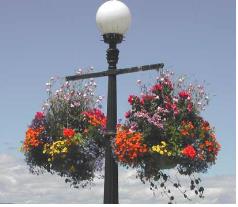
Hanging baskets beautify the downtown.
f. Water Quality and Urban Runoff in Redevelopment Areas. Because of the proximity of the downtown to Putah Creek and the potential impact of urban activities on the natural environment, water quality and urban runoff in redevelopment areas are of particular concern. The use of bioswales and landscaped water quality basins represent the preferred approach to urban runoff and stormwater quality control in the D-B zone. Such features add aesthetic character, utilize natural materials, and serve as a functional element that allows for stormwater management.
i. Bioswales and similar natural landscaped runoff control facilities shall be used to enhance appearance of stormwater management methods and allow for groundwater recharge.
ii. Bioswales shall be used to collect surface runoff before it crosses pavement areas and to reduce ponding and damage to walkways. Bioswales shall be graded to direct water away from paved areas into detention basins.
iii. Bioswales shall utilize a slope that is steep enough to prevent ponding and shallow enough to slow water velocity. Soils must not readily drain water; the goal is to get cleaner water to flow downstream. Recommended slopes of one to four percent should be used. Flow should be sufficiently low enough to provide adequate residence time within the channel. Flow depth should not be taller than the vegetation (a maximum depth of four inches is recommended). Final design of bioswales shall be subject to the approval of the city engineer.
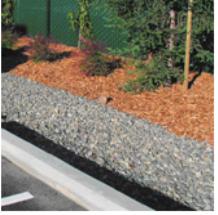
A small bioswale along the edge of a parking area.
iv. Porous paving shall be considered when designing paved areas. If used, porous paving shall first be approved and shall be applied as directed by the city engineer. (Ord. 2009-10 § 1 Exh. 1 (part))
17.58.070 Architectural and design standards.
The purpose of these architectural and design standards is to guide preservation, improvements, renovations, and future development in downtown Winters. These provisions describe and illustrate architectural and design standards that are appropriate for downtown Winters. They establish the criteria used by the city in reviewing proposed development, and are intended to encourage high quality design and development, creativity and innovation in downtown Winters.
Please note that the mandatory development standards contain the words “shall,” “must,” or “will.” Standards that contain the word “should” mean that an action is required unless a determination is made that the intent of the standard is satisfied by other means.
A. Site Design. Siting involves a project’s relationship to the property, the street, and adjacent buildings. In the downtown area, buildings should be sited in ways that provide a comfortable and safe environment for pedestrians while accommodating vehicles.
1. Building Siting.
a. Most of the building street wall should meet the front setback lines, except for special entry features, architectural articulation, and plaza areas or other public spaces.
b. Residential buildings should be oriented towards the street for safety considerations as well as to encourage social interaction among neighbors.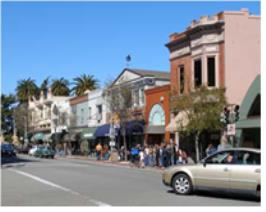
Buildings should meet the front setback lines to create a continuous building street wall.
2. Compatibility with Adjacent Uses.
a. Commercial uses shall reduce potential nuisances to adjoining residential property by locating trash enclosures, loading areas, and restaurant vents away from residential uses and by proper screening of utilities and equipment.
b. Commercial uses developed as part of a mixed-use project (with residential units) should not be noise-intensive.
c. A fifteen (15) foot minimum landscaped buffer should be provided between a commercial or mixed-use structure and an adjoining residential parcel unless the type of building use calls for a wall to be located along the property line and the wall(s) include a sound-reducing design.
d. Drive-thrus are not allowed within the downtown form-based code area.
3. Refuse, Storage, and Equipment Areas.
a. Trash storage must be fully enclosed and incorporated within the main structures or separate freestanding enclosures. Where practical, storage at each unit is preferred over common enclosures. Trash storage cannot be placed under stairways.
b. All trash and garbage bins should be stored in an approved enclosure. Refuse containers and service facilities should be screened from view by solid masonry walls with wood or metal doors. Chainlink fencing with slating is generally discouraged. Use landscaping (shrubs and vines) to screen walls and help deter graffiti.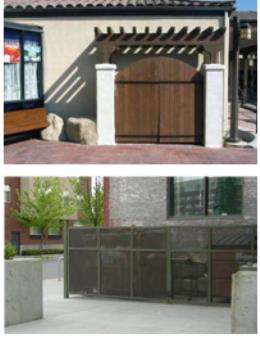
Trash bins and other service areas should be located away from public streets and be screened from view.
c. Trash enclosures should allow convenient access for commercial tenants. Siting on-site service areas in a consolidated and controlled environment is encouraged.
d. Trash enclosures should be located away from residential uses to minimize nuisance for the adjacent property owners. The enclosure doors should not interfere with landscaping, pedestrian, or vehicle path of travel.
e. Trash enclosures should be architecturally compatible with the project.
f. Refuse storage areas that are visible from an upper story of adjacent structures should provide an opaque or semi-opaque horizontal cover/screen to reduce unsightly views. The screening should be compatible with the design of adjacent development and shall be approved by the fire department.
g. Every public, quasi-public, commercial, or mixed-use development containing two or more units or businesses shall provide at least one publicly accessible on-site trash receptacle.
h. Public trash cans along the street or a paseo may not be located near eating areas.
i. Location and design of trash storage and enclosures is subject to approval by the fire department.
B. Architectural Standards. The purpose of the architectural standards is to guide improvements, renovations, and future development in downtown Winters to be consistent with the vision and goals for the area as detailed in the downtown master plan and this zoning code. These guidelines describe and illustrate building and landscape designs that are appropriate for downtown Winters. They establish the criteria used by the city in reviewing proposed development, and are intended to encourage high quality design and development, creativity and innovation.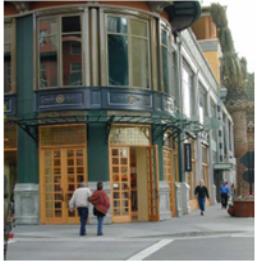
Buildings at street corners should be oriented to both intersecting streets with a building entrance fronting directly onto the corner.
1. General Design Standards.
a. Awnings and overhangs should be used in conjunction with street trees to provide visual interest and shade for pedestrians.
b. Any seismic structural upgrading should be conducted in the interior of the building, if possible, unless the structural elements blend into the architecture of the exposed facade. Seismic structural upgrades shall not block or alter the original design of storefront windows.
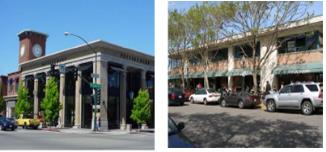
Facades of larger buildings should be divided into pedestrian-scaled modules.
2. Building Height, Form, and Mass.
a. Incorporate elements such as covered walkways, building arcades, and trellises into the design of large structures which provide a transition to the human scale, particularly at the ground.
b. Create a comfortable and human scale of structures.
c. Corner buildings should have a strong tie to the front setback lines of each street. Angled building corners or open plazas are encouraged at corner locations.
d. On sites with multiple structures, buildings should be linked visually and physically. These links can be accomplished through architecture and site planning, such as trellises, colonnades or other open structures combined with landscape and walkway systems.
e. As a general rule, the scale of building(s) on a site edge should be compatible with the scale of adjoining development. Where surrounding development is of a small scale, large-scale buildings should be located internal to the site and transition down in scale as the outer edge of the site approaches.
f. Do not place the backs of buildings along a street frontage. Include entrances or public views into the site or building. If the rear of the building must be located along a street because of site constraints, then architectural detailing shall be included that provides the illusion of being a front to the building.
g. Building mass should be parallel or on axis with adjacent street(s).
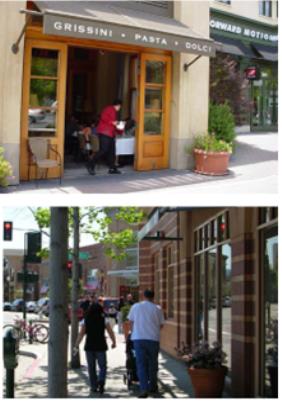
Primary facades should create a high level of transparency along the street.
3. Facades, Windows, and Doors.
a. Design building entrances as prominent and easily identifiable; also, form a transition between the exterior and interior. Provide building entries with adequate lighting for security. Any building with more than seventy-five (75) feet of street frontage should have at least one primary entry.
b. Building entrances should be designed to protect patrons and employees from the elements.
c. Elements of architecture including window and door placement shall be designed to add variety and interest to the project.
d. Windows shall not be blocked from inside a building due to retail display racks, plywood sheets, posters, et cetera.
e. Additional sunlight should be brought into large developments through the use of atriums and skylights.
f. The use of security grilles at windows and doors is highly discouraged. If security grilles are necessary, they shall be placed inside the building, behind the window display area, or otherwise hidden from public view.
g. The physical design of building facades should vary at least every fifty (50) linear feet (quarter block). This can be achieved through such techniques as:
i. Architectural division into multiple buildings;
ii. Break or articulation of the facade;
iii. Significant change in facade design;
iv. Placement of window and door openings; or
v. Position of awnings and canopies.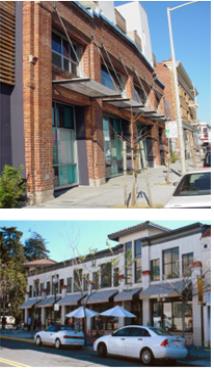
Durable materials should be used, particularly at ground level, where they are more visible.
h. The design of the project shall be expressed on all exterior elevations of the building.
i. If maintaining a horizontal rhythm or alignment as a result of infill construction is not feasible, the use of canopies, awnings, or other horizontal devices should be included to maintain a (shared) horizontal rhythm.
j. Mullions. “True divided light” windows or sectional windows are recommended where a divided residential window design is desired; “snap-in” grilles or mullions shall not be used.
k. Primary building entrances should be oriented toward the street.
l. In no case shall any facade consist of a blank wall.
4. Roofs and Upper Story Details.
a. Roofs should be given design considerations and treatment equal to that of the rest of the building exteriors.
b. Roofline elements should be developed along all elevations.
c. Articulate side and rear parapet walls by using height variations, relief elements, and thoughtfully designed scuppers, downspouts, and expansion joints.
d. Cornice lines of new buildings (a horizontal rhythm element) should transition with buildings on adjacent properties to avoid clashes in building height.
e. The visible portion of sloped roofs should be sheathed with a roofing material complementary to the architectural style of the building and other surrounding buildings.
f. The flat roofs of commercial buildings are encouraged to be used for outdoor lounges and dining areas when appropriate.
g. Access to roofs should be restricted to interior access only.
5. Walls and Fences.
a. Walls and fences should be integrated with the overall building and site design, and shall not exceed three feet in height in the front or side yards in order to avoid the appearance of being a “fortress.”
b. The use of chainlink, fabric, or concrete block fencing is prohibited.
c. Fencing shall not obscure the front elevation of the primary structure on the property. Therefore, front yard privacy fences should not be allowed. Structural members of a fence should be turned in to face into the property.
d. The finished side of the fence should be presented to the street. On corner lots, the guidelines apply to the front yard and street side yard of the property.
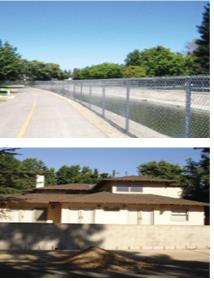
Undesirable Fencing
6. Building Materials and Colors.
a. Buildings and structures should be constructed with durable, low-maintenance, and timeless building materials of the same or higher quality as surrounding developments.
b. Metal seam, clay tile, concrete tile, or a similar grade of roofing material shall be used on all visible pitched roofs.
c. Factory-built, prefabricated, premanufactured buildings, portable, and similar structures, while generally discouraged, may be allowed and shall be designed in accordance with these standards.
d. All building materials shall be properly installed.
e. Horizontal material changes should not occur at external corners, but may occur at interior corners, or at other logical terminations.
f. Reflective materials should not be used to clad a building; however, if reflective materials must be used to protect the integrity of the architectural design, then the material absolutely shall not be a nuisance to the occupants of the existing surrounding structures, or a safety hazard to any type of traffic.
g. All abandoned materials including pipes, conduits, wires, and signs shall be removed and sign anchors shall be patched to match adjacent surfaces. Operational pipes, conduits, etc., must be hidden.
h. Mixed-use commercial developments that contain residential units on the upper levels shall utilize materials with known vibration and sound-reduction qualities in order to minimize noise impacts.
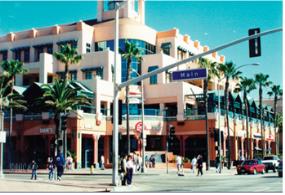
Mixed-Use Development
i. Corrugated metal is an acceptable building material as long as it is not visible from a public street. However, it is acceptable for corrugated metal to be visible from an alley.
j. Colors should be consistent with an historic small, rural town including, but not limited to, shades of brown and dark reds, yellows, and greens. A wide variety of colors should be considered, and accent colors are encouraged. In no case shall color be used to deny a project, except that black as a primary building color shall be prohibited due to its severe nature. Brick shall not be painted unless it has been determined by the community development department that the brick has lost its “fire face” and painting is necessary to assist in slowing the degradation of the brick and mortar.
k. Stucco is discouraged for use as a building material unless it exhibits a high quality of workmanship and finish.
7. Hardscape Materials.
a. Hardscape materials used in pedestrian-oriented spaces such as plazas, paths and sidewalks shall be attractive, durable, slip-resistant, of high quality, and compatible in color and pattern with a project’s design. Surfaces in pedestrian circulation areas shall be constructed from materials that provide a hard, stable surface and that permit maneuverability for people of all abilities.
b. Pedestrian pathways crossing an on-site vehicle drive aisle, loading area, or parking area shall be made identifiable by the use of an alternative hardscape material such as pavers or patterned, stamped or colored concrete.
c. The primary hardscape materials used for pedestrian spaces shall be high quality poured-in-place concrete and silver-toned concrete.
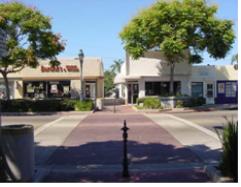
Pedestrian pathways are distinguished through the use of colored materials.
8. Franchise/Corporate.
a. The scale, design, and materials of franchise/corporate architecture should be consistent with adjacent buildings.
b. The city recognizes the unique development constraints for corporate retailers to accommodate the sales volume and vehicle parking demand of their users. The city encourages creative design solutions for franchise retail development to minimize the “one size fits all” look of corporate architecture.
9. Security.
a. Create a secure development for both the site and its occupants by minimizing opportunities for crime and undesirable activities through natural surveillance, access control, and activities.
b. Locate buildings and windows to maximize visibility of entryways, pathways, and parking lots.
c. Adequate security and safety lighting for pedestrians from parking spaces to all building entries and exits shall be provided.
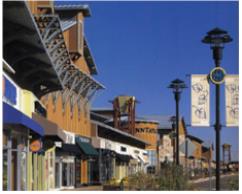
Provide adequate security lighting for pedestrians.
d. Street addresses for commercial, public, or multi-use residential buildings shall be easily visible on the front of the building both during the daytime, and at night.
C. Lighting. In downtown Winters lighting fixtures within developments should be attractively designed to complement the architecture of the project and surrounding development, and should improve the visual identification and safety of residences and businesses. Additionally, consideration should be given to the effects of light pollution on the environment, as well as energy conservation technologies.
1. General Design Standards.
a. Lighting shall provide security and visual interest.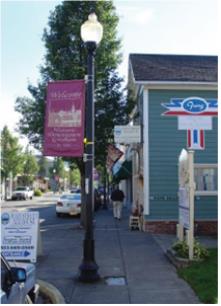
Lighting should provide security and visual interest.
b. All exterior doors, aisles, passageways and recesses shall be equipped with a lighting device providing a minimum maintained one foot-candle of light at ground level during hours of darkness. Vandal-resistant covers should protect lighting devices.
c. Decorative accent lighting and fixtures above the minimum one foot-candle illumination levels of surrounding parking lots should be provided at vehicle driveways, entry throats, pedestrian paths, plaza areas, and other activity areas.
d. Exterior lighting shall be sited and installed in a manner to minimize glare and light spillage beyond property lines. Outdoor light fixtures shall be the lowest wattage necessary to accomplish adequate lighting. Lighting shall be down-lit, shielded, and directed away from areas not intended to be lit and from the night sky. All light fixtures shall be installed and shielded in such a manner that no visible light is emitted from the fixture at angles above the horizontal plane.
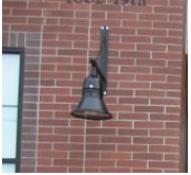
Lighting directed downward (down-lit) with shielding.
e. Lighting fixtures should be attractively designed to complement the architecture of the project.
f. Lighting should improve visual identification of residences and businesses and create an inviting atmosphere for passersby.
g. Wall-mounted lights should be used to the greatest extent possible to minimize the total number of freestanding light standards.
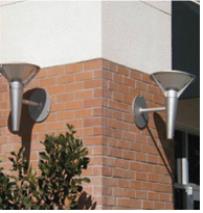
Wall-mounted lights should be used to the greatest extent possible.
h. Parking lot lighting fixtures should not exceed thirty-five (35) feet in height. When within fifty (50) feet of residentially zoned properties, fixtures should not exceed twenty (20) feet.
i. Light standards within parking lots should be designed with raised bases to protect them from damage by vehicles.
j. Provide street lighting that is scaled for the pedestrian while still meeting vehicular needs. On local streets and within project sites, fixtures should be primarily oriented towards pedestrians’ needs. On major streets, light fixtures serve to illuminate both pedestrian areas and roadways. Consider the location and intended audience when choosing a light fixture for a project.
k. Lighting for a parking lot or structures should be evenly distributed and provide pedestrians and drivers with adequate visibility and safety level at night.
l. Lighting shall be maintained along the pathway of “urban trails” (i.e., those between buildings and in dense areas of the city) at a level sufficient to make the trail and abutting landscaping visible and safer at night while not detracting from the physical and aesthetic aspects of the trail and spilling onto abutting residential uses. Light fixtures should be vandal-resistant.
m. The light source used in outdoor lighting should provide a white light for better color representation and to create a more pedestrian-friendly environment.
n. Low pressure sodium lamps are prohibited.
o. Lighting should be consistent with the historic small-town character of Winters.
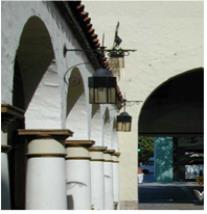
Lighting should add drama and character to a building while being consistent with its character.
D. Sign Design. Signs in the downtown form-based code area are regulated by Chapter 17.80 (Signs) of the Winters Municipal Code. The following design standards are intended to guide the design of signs in the downtown and will be used as a basis of consideration for review of sign permits and management of signs in the downtown:
Design, color, materials, size, and placement are all important in creating signs that are architecturally attractive and integrated into the overall site design. Signs that are compatible with the surroundings and effectively communicate a message will promote a quality visual environment.
1. General Design Standards.
a. Design signs in harmony with the style and character of the development and as an integral design component of the building architecture, building materials, landscaping, and overall site development.
b. Sign letters and materials should be professionally designed and fabricated.
c. Exposed conduit and tubing (raceway) are prohibited. All transformers and other equipment shall be concealed.
d. All signs shall be maintained in good repair, including the display surface, which shall be kept neatly painted or posted.
e. The exposed backs of all signs visible to the public shall be suitably finished and maintained.
f. The use of retractable awnings as a signage tool is acceptable.
g. Nonconforming city-designated “heritage signs” shall be protected.
2. Placement.
a. Signs should be generally free of obstructions when viewed from different angles. However, trees or other landscaping that grow to a point that they obstruct the view of a sign or make it illegible shall not be grounds for removal or trimming of the plant(s).
b. Utilize a consistent proportion of signage to building scale, such as one-third text to two-thirds wall area or one-quarter text to three-quarters wall area. See Figure 17.58-4 (Text Scale).
Figure 17.58-4: Text Scale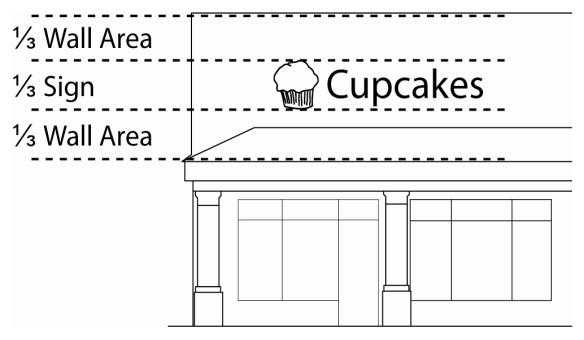
3. Materials.
a. Paper and cloth signs are appropriate for interior temporary use only and are not permitted on the exterior of a building.
b. A-frame signs shall be constructed of architecturally compatible materials such as metal or wood. Plastic or similar material A-frame signs are prohibited.
c. The use of neon is permitted in the D-A zone if it fits with the style of the architecture (e.g., art deco) and is not a nuisance (e.g., produces glare) to the surrounding properties.
Sign Tips: Colors and Materials
- Use exterior materials, finishes, and colors in harmony with, or an upgrade to, those of the buildings or structures on site.
- The selected materials need to contribute to the legibility of the sign. For example, glossy finishes are often difficult to read because of glare and reflections.
- Contrast is an important influence on the legibility of signs. Light letters on a dark background or dark letters on a light background are most legible.
- Limit the total number of colors used in any one sign. Small accents of several colors may make a sign unique and attractive, but the competition between large areas of many different colors decreases readability.
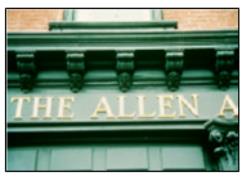
Exterior materials, finishes, and colors should be the same or similar to those of the buildings or structures on site.
4. Sign Legibility.
a. Avoid spacing letters and words too close together. Crowding of letters, words or lines will make any sign more difficult to read. Conversely, over-spacing these elements causes the viewer to read each item individually, again obscuring the message. As a general rule, letters should not occupy more than seventy-five (75) percent of the sign panel area.
Sign Tips: Legibility
- Use a brief message whenever possible. Fewer words help produce a more effective sign. A sign with a brief, succinct message is easier to read and looks more attractive.
- Limit the number of lettering styles in order to increase legibility. A general rule to follow is to limit the number of different letter types to no more than two for small signs and three for large signs.
- Use symbols and logos in the place of words whenever appropriate. Pictographic images will usually register more quickly in the viewer’s mind than a written message.
- Avoid hard-to-read, overly intricate typefaces and symbols. Typefaces and symbols that are hard to read reduce the sign’s ability to communicate.
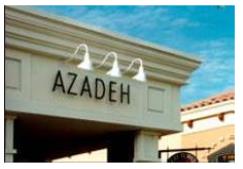
A brief message with simple lettering is easy to read and identify.
5. Sign Illumination.
a. The light from an illuminated sign shall not be of an intensity or brightness that will create glare or other negative impact on residential properties in direct line of sight to the sign.
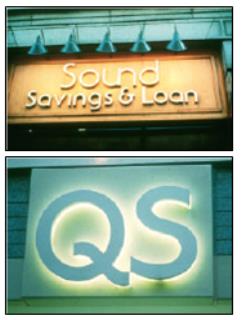
Light source must be directed against the sign such that it does not shine into adjacent property or cause glare for motorists and pedestrians.
b. Whenever indirect lighting fixtures are used (fluorescent or incandescent), care shall be taken to properly shield the light source to prevent glare from spilling over into residential areas and any public right-of-way.
c. Internally illuminated plastic box “canned” signs are prohibited. Individually illuminated channel letters are acceptable.
d. Signs shall not have blinking, flashing, or fluttering lights, or other illumination devices that have a changing light intensity, brightness, or color.
e. Light sources shall utilize energy-efficient fixtures to the greatest extent possible and shall comply with Title 24 of the California Code of Regulations (California Building Standards Code).
Sign Tips: Illumination
- If the sign can be illuminated by an indirect source of light, this is usually the best arrangement because the sign will appear to be better integrated with the building’s architecture. Light fixtures attached to the front of the structure cast light on the sign and the face of the structure as well.
- Individually illuminated letters should be backlit. Signs comprised of individual letters mounted directly on a structure can often use a distinctive element of the structure’s facade as a backdrop, thereby providing a better integration of the sign with the structure.
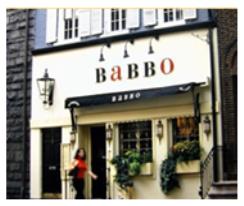
Spotlights are preferred for wall and projecting signs.
(Ord. 2009-10 § 1 Exh. 1 (part))
17.58.080 Special use regulations and other standards.
The following special use regulations are to address concerns and provide standards for the following types of development and issues specific to downtown Winters. These standards are intended to provide guidance to planners, developers, builders, businesses, and residents to ensure consistency with the vision and goals defined in the downtown master plan and this zoning code.
A. Live/Work. Live/work units are built spaces that function predominantly as work spaces and secondarily as residences.
Live/work units shall comply with the following standards:
1. The unit must contain a cooking space and bathroom in conformance with applicable building standards.
2. Adequate and clearly defined working space must constitute no less than fifty (50) percent of the gross floor area of the live/work unit. Said working space shall be reserved for and regularly used by one or more persons residing there.
3. At least one residence in each live/work unit shall maintain at all times a valid city business license for a business on the premises.
4. Persons who do not reside in the live/work unit may be employed in a live/work unit when the required parking is provided.
5. Customer and client visits are allowed when the required parking is provided.
6. No portion of a live/work unit may be separately rented or sold as a commercial space for a person or persons not living on the premises, or as a residential space for a person or persons not working on the premises.
B. Newspaper Racks. For the purpose of this section, “newspaper rack” is defined as any type of unattended device placed upon or abutting any public right-of-way for the vending, display, or free distribution of newspapers, news periodicals, or other written materials.
1. Permission to install a newspaper rack requires an encroachment permit from the city of Winters.
2. No person shall place, erect, install, service, stock or maintain any newspaper rack or courtesy bench which obstructs or intrudes upon, in whole or in part, any public right-of-way. A minimum of four feet of clear walkway must be maintained.
3. Newspaper racks shall not be located directly in front of a building entrance.
4. Newspaper racks may not be anchored to a light pole, street sign, or other similar street element.
5. Any vendor choosing to distribute free publications in downtown Winters shall use modular newspaper racks provided and maintained by the city. Individual privately owned freestanding newspaper racks shall not be permitted for the purpose of distributing free publications.
C. Public Art. For the purpose of this section, “public art” in downtown Winters is defined as permanent or temporary works of art in the public realm, whether part of a building or freestanding.
1. Public art shall be incorporated into public plazas, parks, and municipal buildings. Additionally, the incorporation of public art into private development projects is strongly encouraged.
2. Possible types of public art include but are not limited to the following options:
a. Building features and enhancements such as bike racks, gates, benches, water features, or shade screens, which are unique and/or produced in limited editions by a professional artist.
b. Landscape art enhancements such as walkways, bridges, or art features within a garden.
c. Murals or mosaics covering walls, floors, and walkways. Murals may be painted or constructed with a variety of materials, including the use of imbedded and nontraditional materials.
d. Sculptures, which can be freestanding, wall-supported or suspended, kinetic, electronic, and made of endurable materials suitable for the site.
e. Fiberwork, neon, or glass artworks, photographs, prints, and any combination of media including sound, film, and video systems, or other interdisciplinary artwork applicable to the site. The use of light, sound, film, and video shall not create a nuisance for neighboring properties.
f. Community arts projects resulting in tangible artwork, such as community murals, sculptures, or kiosks.
D. Storefront Vacancy. For the purpose of this section, a “storefront vacancy” in downtown Winters is defined as a vacant commercial ground floor (street level) space in any otherwise occupied or unoccupied building.
1. Vacant storefronts shall be properly locked and secured to prevent unauthorized trespassing during the period of vacancy.
2. The exterior facade of vacant storefronts shall be maintained by the property owner at the same level of quality as surrounding occupied storefronts and buildings.
3. Property owners of vacant storefronts shall implement creative temporary alternative uses of storefront window areas such as utilizing them as a display area for community info, public art by local artists, and merchandise from other stores.
4. Property owners of vacant storefronts shall consult with the city’s economic development staff regarding possible available tenants.
5. Vacant storefronts shall not be boarded up, or otherwise appear derelict or abandoned.
6. An adequate level of exterior security lighting shall be regularly maintained regardless of storefront occupancy status.
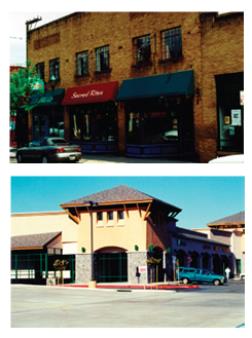
Appropriately Maintained Storefronts
(Ord. 2009-10 § 1 Exh. 1 (part))


